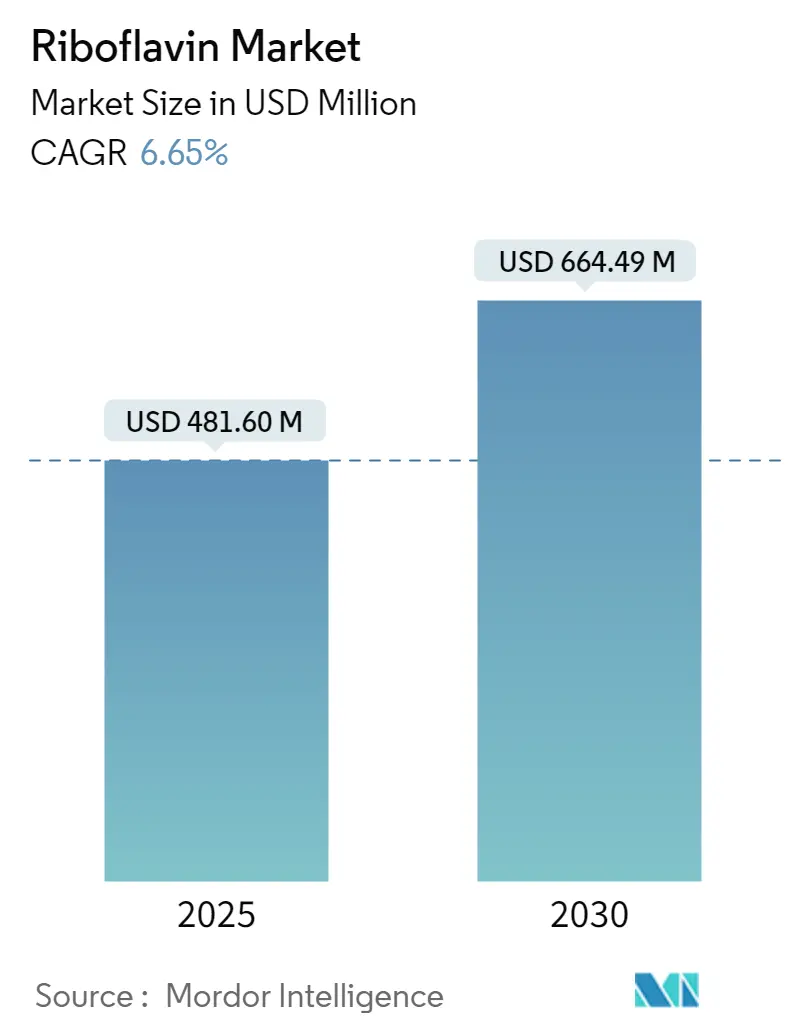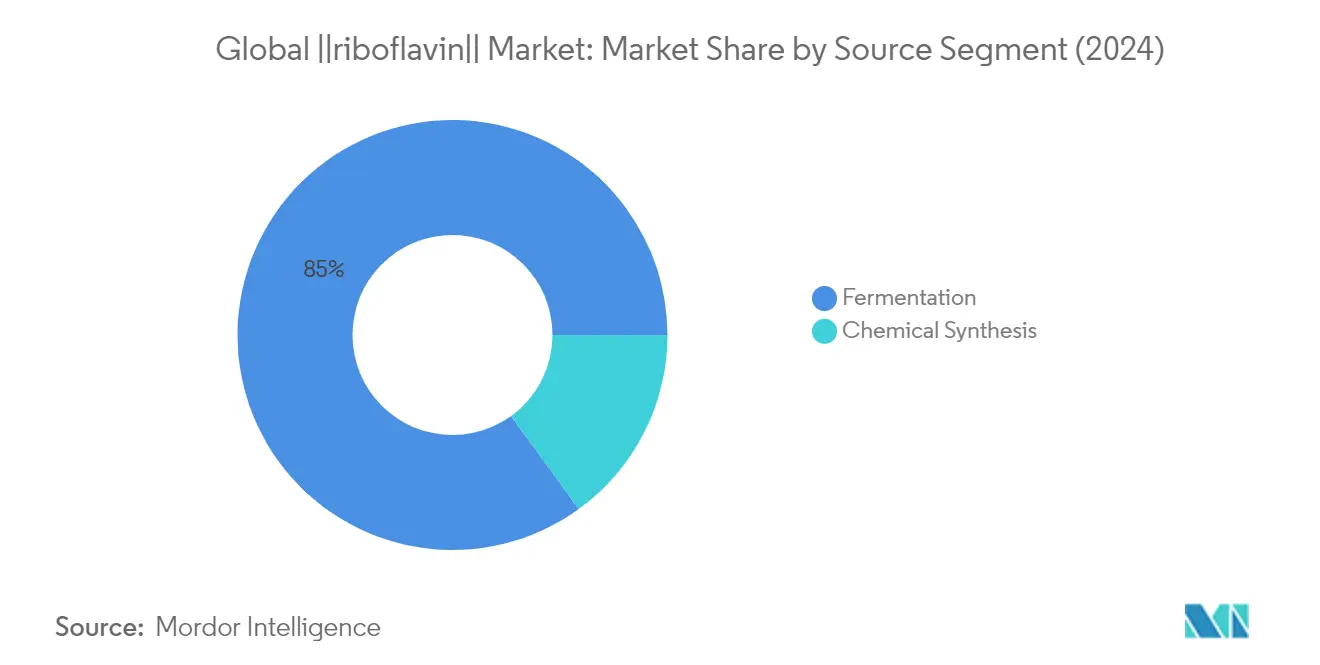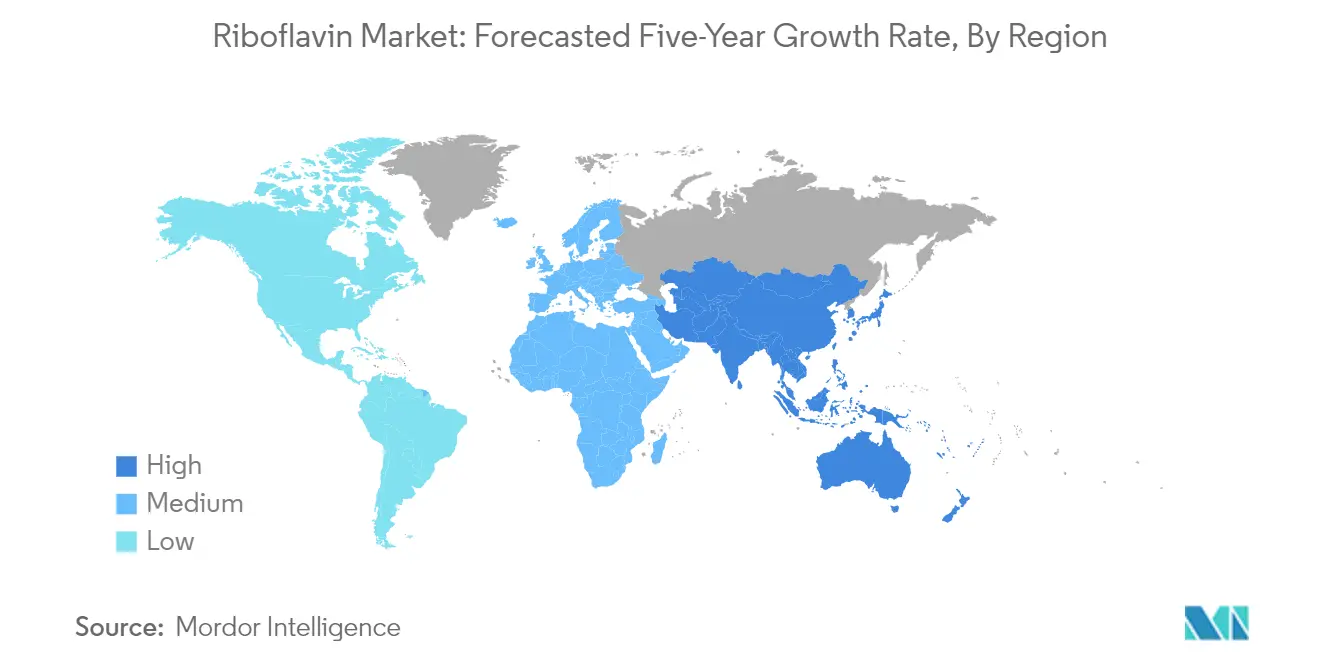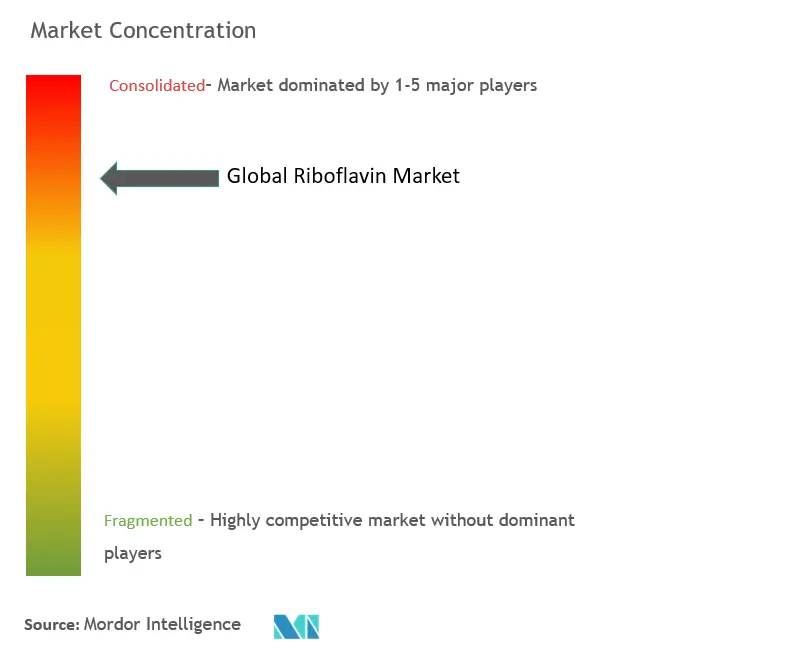Riboflavin Market Size and Share

Riboflavin Market Analysis by Mordor Intelligence
The Riboflavin Market size is estimated at USD 481.60 million in 2025, and is expected to reach USD 664.49 million by 2030, at a CAGR of 6.65% during the forecast period (2025-2030).
The riboflavin industry is experiencing significant transformation driven by evolving consumer preferences and increasing health consciousness worldwide. Food fortification has emerged as a crucial strategy for preventing micronutrient malnutrition, with approximately 31% of the world's industrially milled wheat flour now being fortified with essential nutrients, including riboflavin. This trend is particularly prominent in developed markets where consumers are increasingly seeking functional foods that offer additional health benefits beyond basic nutrition. The shift towards preventive healthcare and wellness has led manufacturers to incorporate vitamin B2 in various product formulations, from breakfast cereals to dairy alternatives.
The industry is witnessing substantial innovation in production methods, with a notable shift from chemical synthesis to biotechnology-based fermentation processes. Leading manufacturers are investing in research and development to develop more sustainable and cost-effective production methods. This transition is particularly significant as fermentation routes allow for single-step production of vitamin B2, making it more economically and environmentally viable compared to traditional multi-stage chemical processes. The industry's focus on sustainability has also led to increased efforts in developing GMO-free riboflavin products, particularly for organic food applications.
The personal care and cosmetics sector has emerged as a rapidly growing application area for riboflavin, driven by increasing consumer awareness of its benefits for skin health and anti-aging properties. Manufacturers are incorporating riboflavin into various beauty and skincare formulations, from serums to supplements, capitalizing on its ability to improve skin texture and combat visible signs of aging. The ingredient's natural properties align well with the clean beauty movement, where consumers are seeking products with naturally-derived, scientifically-proven ingredients.
The animal nutrition sector represents another significant market dimension, with riboflavin being essential in feed formulations for optimal livestock health and productivity. The ingredient plays a crucial role in animal metabolism, tissue repair, and growth promotion, making it indispensable in modern animal husbandry practices. The trend towards organic livestock production has created new opportunities for GMO-free riboflavin products, although supply challenges persist in meeting the growing demand from organic producers. Industry stakeholders are actively working on developing alternative sources and production methods to address this supply-demand gap in the organic sector.
Global Riboflavin Market Trends and Insights
Increasing Demand from Fortified Food and Beverages Application
The growing emphasis on food fortification as a means to improve health and wellness, rather than just preventing micronutrient malnutrition, has become a significant driver for the riboflavin market. According to the Food Fortification Initiative (FFI), approximately 31% of the world's industrially milled wheat flour is currently fortified with essential nutrients, including riboflavin, iron, zinc, folic acid, niacin, thiamin, and vitamin B2. This widespread adoption of fortification practices is supported by various government initiatives, particularly in developing countries, where organizations like the Food and Agricultural Organization (FAO) and World Health Organization (WHO) have identified food fortification as a key strategy to combat malnutrition. The increasing consumer awareness regarding vitamin B2 deficiency has prompted manufacturers to actively expand their product offerings with riboflavin fortification.
The market is witnessing significant product innovations as companies respond to the growing demand for fortified food and beverages. For instance, in October 2022, Fonterra expanded its product portfolio by launching BioKodeLab, a supplement brand aimed at improving cognitive performance, which includes riboflavin among other essential nutrients. The fortification trend extends beyond traditional food products to include a wide range of applications in breakfast cereals, raised bread, flatbread, biscuits, and cereal-based beverages. Food manufacturers are particularly focusing on cereals and flour products due to their widespread consumption and cost-effectiveness as vehicles for fortification. This trend is further supported by regulatory bodies like the FDA, which recommends the fortification of cereal grains with various B vitamins, including riboflavin.
Multifunctionality and Wide Application
The versatility of riboflavin across multiple industries has emerged as a crucial market driver, with applications spanning food processing, cosmetics, pharmaceuticals, and animal feed sectors. In the pharmaceutical and nutraceutical industries, riboflavin plays a vital role in the development of multivitamin and multimineral supplements, B-complex vitamins, and various dose forms of vitamin B2 capsules and tablets. The ingredient's significance in animal feed applications is particularly noteworthy, as it serves as a growth promoter and is essential for maintaining optimal health in livestock. Additionally, riboflavin's high collagen content makes it valuable in the cosmetics industry for skin and hair nourishment, leading to its increased incorporation in personal care products.
The expanding application scope is further driven by the rising consumer demand for plant-based alternatives, prompting manufacturers to invest in research and development for innovative riboflavin solutions. Major industry players like BASF SE, MTC Industries Inc., and DSM are actively developing plant-based riboflavin ingredients to cater to the growing vegetarian and vegan consumer base. This adaptation to changing consumer preferences has opened new avenues for riboflavin application across food and beverages, personal care products, nutraceuticals, and animal feed sectors. The ingredient's natural yellow to orange-yellow color also makes it valuable as a food colorant, particularly in bakery products and beverages, providing manufacturers with dual functionality in both fortification and coloring applications.
Segment Analysis: By Source
Fermentation Segment in Global riboflavin Market
The fermentation segment dominates the global riboflavin market in 2024, accounting for approximately 85% of the total market share. This dominance is primarily attributed to the segment's cost-effectiveness and environmental sustainability compared to traditional chemical synthesis methods. Major manufacturers like BASF, DSM, and Hubei Guangji Pharmaceutical have adopted fermentation processes using microorganisms such as Ashbya gossypii, Candida famata, and Bacillus subtilis to produce riboflavin. The fermentation route allows single-step production of vitamin B2, making it significantly more efficient than multi-stage chemical processes. Additionally, the growing demand for naturally sourced ingredients and increasing focus on sustainable production methods have further strengthened the position of fermentation-based riboflavin production in the global market.

Chemical Synthesis Segment in Global riboflavin Market
The chemical synthesis segment is projected to experience limited growth during 2024-2029 as manufacturers continue to transition away from this traditional production method. This shift is primarily driven by the segment's higher production costs, complex multi-step processes, and environmental concerns associated with chemical synthesis. The process typically involves 6-9 chemical reaction steps, including oxidation, displacement, transposition, acidification, lactonization, reduction, condensation, coupling, and cyclization, making it both time-consuming and resource-intensive. Furthermore, the final products from chemical synthesis often contain impurities with certain toxicity that are difficult to eliminate, leading to quality control challenges and increased production costs. These factors, combined with stricter environmental regulations and growing consumer preference for naturally produced ingredients, continue to impact the segment's growth potential.
Segment Analysis: By Form
Powder Segment in riboflavin Market
The powder segment continues to dominate the global riboflavin market, commanding approximately 91% of the total market share in 2024. This substantial market position is attributed to the segment's widespread application across multiple industries, including food and beverages, pharmaceuticals, and animal feed sectors. The powder form of riboflavin is particularly preferred due to its superior stability, longer shelf life, and ease of incorporation into various formulations. Major manufacturers like BASF SE and DSM have been focusing on developing innovative powder formulations that offer enhanced flowability and dispensability, making them particularly suitable for use as colorants in powder food products and fortification of flour and other staple foods. The segment's dominance is further strengthened by its cost-effectiveness in bulk manufacturing and transportation, as well as its versatility in different application areas ranging from dietary supplements to animal feed additives.
Liquid Segment in riboflavin Market
The liquid segment is emerging as the fastest-growing segment in the global riboflavin market, projected to grow at approximately 7% through 2024-2029. This accelerated growth is primarily driven by the increasing demand for liquid formulations in beverage applications, particularly in functional drinks and fortified beverages. The segment is witnessing significant innovation in terms of product development, with manufacturers focusing on creating stable liquid formulations that offer better bioavailability and easier incorporation into liquid-based products. The growth is further supported by the rising consumer preference for ready-to-drink functional beverages and liquid supplements, especially in developed markets. Manufacturers are increasingly investing in advanced liquid formulation technologies to improve the stability and efficacy of liquid riboflavin products, while also addressing the growing demand for natural and clean-label solutions in the beverage industry.
Segment Analysis: By Application
Animal Feed Segment in riboflavin Market
The animal feed segment continues to dominate the global riboflavin market, commanding approximately 31% of the total market share in 2024. This significant market position is primarily driven by the essential role of riboflavin in animal nutrition, particularly in poultry and livestock feed applications. The segment's prominence is attributed to riboflavin's crucial function in metabolizing proteins, fats, and carbohydrates in animals, while also maintaining healthy reproductive functions and proper growth. The increasing global demand for meat and dairy products has further strengthened this segment's position, as riboflavin supplementation is vital for optimal livestock health and productivity. Additionally, the growing focus on high-quality animal feed products and the rising awareness about the importance of vitamin B2 in animal nutrition have contributed to the segment's market leadership.
Pharmaceuticals Segment in riboflavin Market
The pharmaceuticals segment has emerged as the fastest-growing application in the riboflavin market, with an expected growth rate of approximately 8% during 2024-2029. This robust growth is driven by increasing applications in various pharmaceutical formulations and the rising awareness about riboflavin's therapeutic benefits. The segment's expansion is further supported by growing research and development activities exploring riboflavin's potential in treating various medical conditions, including migraines, anemia, and certain metabolic disorders. The pharmaceutical industry's increasing focus on vitamin-based treatments and the rising demand for riboflavin-enriched medications in developing economies are also contributing to this segment's rapid growth. Moreover, the growing trend of preventive healthcare and the increasing use of riboflavin in combination with other vitamins in pharmaceutical preparations are expected to sustain this segment's strong growth trajectory.
Remaining Segments in riboflavin Market by Application
The other significant segments in the riboflavin market include food and beverages, dietary supplements, personal care, and other miscellaneous applications. The food and beverages segment plays a crucial role in meeting the growing demand for fortified foods and functional beverages, particularly in developing regions. The dietary supplements segment continues to expand due to increasing health consciousness and the growing trend of preventive healthcare among consumers. The personal care segment is gaining traction due to riboflavin's benefits in skincare and hair care products, while other applications include its use in various industrial processes and research applications. These segments collectively contribute to the market's diversity and overall growth, each serving specific consumer needs and industry requirements across different regions and applications.
Riboflavin Market Geography Segment Analysis
Riboflavin Market in North America
The North American riboflavin market demonstrates robust growth driven by rapid urbanization, industrialization, and technological innovations, particularly in the animal feed industry. The United States leads the regional riboflavin market, followed by Canada and Mexico. The region's growth is supported by increasing health awareness, rising per-capita income, and wide-ranging applications across various industries, including pharmaceuticals, food fortification, and personal care products.

Riboflavin Market in the United States
The United States dominates the North American riboflavin market, holding approximately 79% market share in 2024. The country's market is primarily driven by the increased demand for riboflavin-infused supplements owing to its multi-utility across all market sectors. The US market benefits from extensive research and development activities, particularly in the pharmaceutical and nutraceutical sectors. The country's robust distribution network and the presence of major market players further strengthen its position in the regional B2 market.
Riboflavin Market in Canada
Canada emerges as the fastest-growing market in North America, with a projected growth rate of approximately 7% during 2024-2029. The Canadian market is characterized by significant growth in dietary supplements due to increasing consumer knowledge about healthier ingredients and rising demand for vitamins and mineral supplements from health-conscious populations. The market has received a substantial boost from evolving regulations around health claims that provide considerable innovative space for supplement manufacturers. The country's focus on research and development in pharmaceutical applications and increasing demand for fortified food products further drive market growth.
Riboflavin Market in Europe
The European riboflavin market showcases strong growth potential, supported by advanced research capabilities and stringent quality standards. Germany leads the market, followed by the United Kingdom, France, Italy, Spain, and Russia. The region's market is characterized by increasing demand for natural and organic products, coupled with growing awareness about health and wellness among consumers.
Riboflavin Market in Germany
Germany maintains its position as the largest riboflavin market in Europe, commanding approximately 26% of the regional market share in 2024. The country's market is driven by its strong pharmaceutical and chemical industries, coupled with advanced research and development capabilities. Germany's robust manufacturing infrastructure and the presence of major market players like BASF SE contribute significantly to its market dominance.
Riboflavin Market in the United Kingdom
The United Kingdom demonstrates the highest growth potential in Europe, with an expected growth rate of approximately 7% during 2024-2029. The UK market is driven by increasing demand for supplements due to prevailing health concerns and rising consumption of sports nutrition products. The country's focus on research and development in pharmaceutical applications and growing demand for fortified food products further accelerates market growth.
Riboflavin Market in Asia-Pacific
The Asia-Pacific riboflavin market exhibits dynamic growth potential, driven by rapid industrialization, increasing disposable incomes, and growing health awareness among consumers. The region encompasses diverse markets, including China, Japan, India, and Australia, each with unique market characteristics and growth drivers.
Riboflavin Market in China
China maintains its position as the dominant force in the Asia-Pacific riboflavin market. The country's market benefits from well-established manufacturing capabilities, extensive research and development activities, and a large consumer base. China's market is particularly strong in the pharmaceutical and animal feed sectors, with significant exports to global markets.
Riboflavin Market in Australia
Australia emerges as the fastest-growing market in the Asia-Pacific region. The country's market is driven by increasing consumer demand for healthy foods and products with added health benefits. The Australian market shows particular strength in the dietary supplements sector, supported by government regulations promoting food fortification and growing consumer awareness about nutritional benefits.
Riboflavin Market in South America
The South American riboflavin market demonstrates steady growth potential, with Brazil and Argentina as key markets. Brazil emerges as both the largest and fastest-growing market in the region, driven by sustained economic growth and increasing demand for functional foods and nutritional supplements. The region's market is characterized by growing urbanization, rising disposable incomes, and increasing awareness about nutritional benefits among consumers.
Riboflavin Market in the Middle East & Africa
The Middle East & Africa riboflavin market shows promising growth potential, with South Africa and Saudi Arabia as key markets. South Africa emerges as both the largest and fastest-growing market in the region, driven by increasing demand for riboflavin-infused supplements and growing awareness about nutritional benefits. The region's market is characterized by expanding pharmaceutical and chemical industries, coupled with growing demand for fortified food products.
Competitive Landscape
Top Companies in Riboflavin Market
The riboflavin market is characterized by companies focusing intensively on research and development activities to maintain their competitive positions. Major players are consistently expanding their geographical presence and production capabilities through strategic facility expansions, particularly in developing economies. Companies are investing heavily in new machinery and efficient production processes while simultaneously strengthening their distribution networks to enhance customer reach. Product innovation remains a key focus area, with manufacturers developing specialized formulations for various applications across the food, pharmaceutical, and personal care sectors. The industry witnesses continuous efforts to improve production techniques, with companies investing in trained labor and advanced technologies to maintain quality standards and operational efficiency.
Consolidated Market with Strong Global Leaders
The riboflavin market exhibits a highly consolidated structure dominated by a few major global players who possess extensive distribution networks and diverse product portfolios. Companies like BASF, DSM, and Guangji Pharmaceutical hold significant market shares, leveraging their robust supply chains and established presence across multiple geographies. These market leaders have built strong relationships with suppliers and maintain quality certifications that create substantial entry barriers for new players. The market demonstrates a pattern of strategic partnerships and collaborations, particularly in developing regions, as companies seek to expand their manufacturing capabilities and strengthen their market positions.
The industry landscape is characterized by the presence of both specialized vitamin manufacturers and large chemical conglomerates, with the latter having advantages in terms of resource allocation and technological capabilities. Market participants actively pursue vertical integration strategies to maintain control over raw material supplies and distribution channels. Companies are increasingly focusing on developing certified product portfolios and expanding their consumer reach through various distribution channels, while also maintaining strong relationships with end-users across different application segments.
Innovation and Distribution Drive Market Success
Success in the riboflavin market increasingly depends on companies' ability to develop innovative products while maintaining cost competitiveness through efficient production processes. Manufacturers need to focus on establishing strong relationships with suppliers and distributors while investing in research and development to meet evolving consumer demands. The ability to comply with stringent regulatory requirements across different regions while maintaining product quality and safety standards has become crucial for market success. Companies must also develop strategies to address the growing demand for natural and clean-label products, particularly in developed markets.
Market participants need to focus on building strong brand recognition and maintaining transparency in their supply chains to gain customer trust. The development of application-specific products and the ability to provide technical support to customers are becoming increasingly important differentiators. Companies must also consider the impact of increasing health awareness among consumers and adapt their product portfolios accordingly. Success in this market requires a balanced approach between maintaining operational efficiency and investing in future growth opportunities through product development and market expansion strategies. The growing awareness of the benefits of Vitamin B2 is also driving demand in the Vitamin B2 market.
Riboflavin Industry Leaders
-
BASF SE
-
Hubei Guangji Pharmaceutical Co. Ltd.
-
Koninklijke DSM NV
-
Shanghai Acebright Pharmaceuticals Group Co. Ltd.
-
Xinfa Pharmaceutical Co. Ltd.
- *Disclaimer: Major Players sorted in no particular order

Recent Industry Developments
- May 2023: DSM-Firmenich AG, the global innovation partner in nutrition, health, and beauty, completed its merger with Firmenich International SA.
- May 2022: Royal DSM agreed to merge with Firmenich. DSM-Firmenich will have four business units - perfumery and beauty, food and beverage, health and nutrition, and animal nutrition, with combined sales of approximately EUR 11.5 billion (USD 13.58 billion).
- December 2021: According to a study conducted by Kobe University, the addition of vitamin B2 to cells exposed to aging stress has been found to enhance the mitochondria's ability to produce energy, effectively preventing cell aging.
Global Riboflavin Market Report Scope
Riboflavin, also known as vitamin B, is a vitamin found in food and sold as a dietary supplement. It is essential to the formation of two significant coenzymes, flavin mononucleotide and flavin adenine dinucleotide.
The global riboflavin market is segmented by form, application, and geography. By form, the market studied is segmented into powder and liquid. Based on application, the market studied is segmented into food and beverage, dietary supplements, animal feed, personal care, pharmaceuticals, and other applications. It provides an analysis of the emerging and established economies across the world, comprising North America, Europe, South America, Asia-Pacific, and Middle East & Africa.
For each segment, the market sizing and forecasts have been done on the basis of value (in USD million).
| Powder |
| Liquid |
| Food and Beverages |
| Dietary Suppplements |
| Pharmaceuticals |
| Animal Feed |
| Personal Care |
| Other Applications |
| North America | United States |
| Canada | |
| Mexico | |
| Rest of North America | |
| Europe | Spain |
| United Kingdom | |
| Germany | |
| France | |
| Italy | |
| Russia | |
| Rest of Europe | |
| Asia-Pacific | China |
| Japan | |
| India | |
| Australia | |
| Rest of Asia-Pacific | |
| South America | Brazil |
| Argentina | |
| Rest of South America | |
| Middle East and Africa | South Africa |
| Saudi Arabia | |
| Rest of Middle East and Africa |
| Form | Powder | |
| Liquid | ||
| Application | Food and Beverages | |
| Dietary Suppplements | ||
| Pharmaceuticals | ||
| Animal Feed | ||
| Personal Care | ||
| Other Applications | ||
| Geography | North America | United States |
| Canada | ||
| Mexico | ||
| Rest of North America | ||
| Europe | Spain | |
| United Kingdom | ||
| Germany | ||
| France | ||
| Italy | ||
| Russia | ||
| Rest of Europe | ||
| Asia-Pacific | China | |
| Japan | ||
| India | ||
| Australia | ||
| Rest of Asia-Pacific | ||
| South America | Brazil | |
| Argentina | ||
| Rest of South America | ||
| Middle East and Africa | South Africa | |
| Saudi Arabia | ||
| Rest of Middle East and Africa | ||
Key Questions Answered in the Report
How big is the Riboflavin Market?
The Riboflavin Market size is expected to reach USD 481.60 million in 2025 and grow at a CAGR of 6.65% to reach USD 664.49 million by 2030.
What is the current Riboflavin Market size?
In 2025, the Riboflavin Market size is expected to reach USD 481.60 million.
Who are the key players in Riboflavin Market?
BASF SE, Hubei Guangji Pharmaceutical Co. Ltd., Koninklijke DSM NV , Shanghai Acebright Pharmaceuticals Group Co. Ltd. and Xinfa Pharmaceutical Co. Ltd. are the major companies operating in the Riboflavin Market.
Which is the fastest growing region in Riboflavin Market?
Asia Pacific is estimated to grow at the highest CAGR over the forecast period (2025-2030).
Which region has the biggest share in Riboflavin Market?
In 2025, the Asia-Pacific accounts for the largest market share in Riboflavin Market.
What years does this Riboflavin Market cover, and what was the market size in 2024?
In 2024, the Riboflavin Market size was estimated at USD 449.57 million. The report covers the Riboflavin Market historical market size for years: 2019, 2020, 2021, 2022, 2023 and 2024. The report also forecasts the Riboflavin Market size for years: 2025, 2026, 2027, 2028, 2029 and 2030.
Page last updated on:
.webp)


